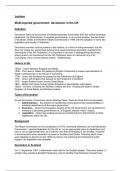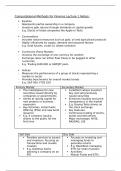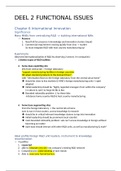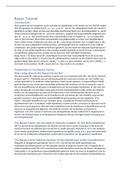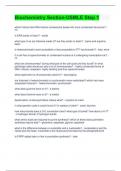Chapter 1; From Problem Solving to Solution Building
The stages of problem solving;
- Description of problem(s) and data collection; the client describes those concerns for which
relief is sought. The practitioner asks follow-up questions to obtain a more detailed
understanding of the client’s problem(s) so that a professional assessment can be made.
- Problem assessment; once the problem is described, the practitioner makes a determination
of the nature of the client’s problem and seriousness. The practitioner draws from a
profession’s acquired knowledge base – its categories, theories, research findings, and
practice wisdom- to make the assessment.
- Intervention planning; together with the client, the practitioner develops a list of goals and
designs a set of interventions intended to solve or reduce the negative consequences of the
problem(s).
- Intervention; the problem-solving actions (interventions) intended to alleviate the problem
are carried out.
- Evaluation and follow-up; as problem-solving actions are taken, the client and professional
monitor the consequences. The information from the monitoring is used to decide whether
the actions taken have been successful. If not adjustments in the level of intervention are
made or new actions are taken. Once the problem is deemed solves by the client and the
practitioner, the process is finished and the client stops services. Often the practitioner and
client make arrangements for follow-up contacts to make sure that the problem does not
recur.
Trust is very important in the helping process. The step to the helping process before problem solving
begins is called relationship building or engagement. They also add a final step, named termination.
In these steps, the practitioner pays special attention o sensitivity, warmth and empathy to establish
and maintain a trusting relationship with the client.
Problem solving in the helping professions has been strongly influenced by the medical model. This
model arose as a result of the impressive achievements in the field of medicine in the late nineteenth
and early twentieth centuries. New knowledge led to a practice model of diagnosis and treatment.
Physicians tried to help patients by diagnosing which diseases were causing their symptoms and then
administering appropriate treatments.
Kuhn (1962) defines a paradigm as an overarching model. It guides theory, research and professional
practice in the field. Since the appearance of the medical model, most helpers follow the same basic
structure when providing assistance to clients. They work from the premise that, before the client
can be helped, the practitioner must figure out what the client is suffering from or struggling with.
This is true whether the practitioner thinks in terms of assessing problems or needs or diagnosing
disorders. Because different problems demand different solutions, the practitioner must make an
accurate assessment in order to determine interventions that will be most effective in each individual
case. Clinical psychologists typically find a problem by psychological testing and proceed to assign it
to a category found in the Diagnostic and Statistical Manual of Mental Disorders.
Rappaport states that the type of research and reasoning best suited in medical solving such ‘puzzles’
converges on the solution; that is, over time increasingly rigorous and ingenious investigations offer
various solutions that gradually converge toward the right answer. Experimental research is an
example of convergent reasoning and has proved very successful in solving scientific and medical
,puzzles. Because individual people and their perceptions about life are so diverse, there is no single
solution for such a problem. Consequently, Rappaport (1981) maintains that divergent thinking is
more appropriate in the helping professions. In divergent thinking, the practitioner surveys several
different perspective about the problem and searches for potential workable solutions. With the goal
of being useful to clients, divergent thinking gives as much weight to the perceptions of clients as to
the expertise of the practitioner.
The mission of the helping professions is to empower clients to live more productive and satisfying
lives. The field focuses on emphasizing on client problems and expert solutions detract from this
mission. If practitioners focus on categories of problems or pathology, clients may become
discouraged and feel that they are victims of some disease or dysfunction. Empowering clients, on
the other hand, indicated the intent to, and the processes of, assisting individuals, groups families
and communities to discover and expend the resources and tools within and around them.
Saleebey calls his version of empowerment the strength perspective. He identifies the following as its
basic assumptions;
- Despite life’s struggles, all persons possess strengths that can be marshaled to improve the
quality of their lives. Practitioners should respect these strengths and the directions in which
clients wish to apply them.
- Clients motivation is increased by a consistent emphasis on strengths as the client defines
them.
- Discovering strengths requires a process of cooperative exploration between clients and
helpers; expert practitioners do not have the last word on what clients need to improve their
lives.
- Focusing on strengths turns practitioners away from the temptations to judge or blame
clients for their difficulties and toward discovering how clients have managed to survive,
even in the most difficult circumstances.
- All environments-even the most bleak-contain resources.
Instead of focusing on problems. Saleebey calls for practitioners to discover, in mutual exploration
with clients, those personal strengths and resources clients can bring to bear on their concerns. He
believes that clients’ frames of reference and perceptions about what would be most useful to create
more satisfying lives for themselves should count for as much as – if not more than- scientific
expertise about problems and solutions.
Solution-building approach; this is an approach to interviewing clients that fosters empowerment by
working within clients’ frames of reference, and it is one with concrete, learnable, widely applicable
techniques. The solution-building approach was pioneered through the work of Steve de Shazer,
Insoo Kim Berg, and their colleagues. They worked inductively by observing individual interviews and
simply paying attention to what was most useful. In the process, they tried to set aside any
preexisting ideas about the nature and origin of client problems. Most other procedures in the field,
by contrast, were developed deductively; they were deduced from an existing theory regarding the
nature and causes of clients problems. De Shazer first realized the idea that there is not a necessary
connection between problem and solution.
, Chapter 2; Solution Building: The Basics
Solution-building interview are organized in large part, around two useful activities.
- The first is the development of well-formed goals within the client’s frame of reference
- The second is the development of solutions based on expectations.
After clients have had an opportunity to describe what in their lives they would like to see changes as
a result of meeting with the practitioner, solution building moves on to these two activities.
There are several characteristics of well-formed goals. Among other things, well-formed goals are
important to the client, small and concrete, and represent the beginning of something different
rather than the end.
Exploring exceptions; exceptions are those occasions in clients’ lives when their problems could have
occurred but did not- or at least were less severe. In solution building the practitioner focuses on the
who, what, when, and where of exception times in clients’ lives instead of the who, what, when,
where and why of problems. Solution-building practitioners use information about exceptions to help
clients devise strategies that solve or reduce their problems.
The stages of solution building;
- Describing the problem; this step resembles the first step of problem solving in that clients
are given an opportunity to describe their problems or concerns. In solution-building, we
spend much less time and effort here than is done in the problem-solving approach. We ask
for fewer details about the nature and severity of client problems, and we do not ask about
possible causes of the problems. Instead, we listen respectfully to clients’ problem talk and
think about ways to turn the conversation toward the next step, which initiates solution talk.
- Developing well-formed goals; here, we work with our clients to elicit descriptions of what
will be different in their lives when their problems are solved.
We do this work at the point where a practitioner who follows the problem-solving
approach would be conducting assessment.
- Exploring for exceptions; at this stage, we ask about those times in clients’ lives when their
problems are not happening or are less severe. We also ask about who did what to make the
exceptions happen.
This step substitutes for intervention planning in the problem-solving approach.
- End-of-session feedback; at the end of each solution-building conversation, we construct
messages for our clients that include compliments and usually some suggestions. The
compliments emphasize what clients are already doing that is useful in solving their
problems. The suggestions identify what clients could observe or do to further solve their
problems. The feedback is based on information that clients have revealed to us in the
conversations about well-formed goals and exceptions. It always focuses on what the client,
given their frames of reference, need to do more of and do differently in order to enhance
their chances of success in meeting their goals.
We construct and give feedback at the point where problem-solving practitioners would
be doing the interventions indicated by their prior assessments.
- Evaluating client progress; in solution building, we regularly evaluate with our clients how
they are doing in reaching solutions satisfactory to them. Customarily, this is done by scaling-
by asking clients to rate progress on a scale of 0 to 10. Once the client progress has been
scaled, we work with clients to examine what still needs to be done before they feel that
their problems have been adequately solved and they are ready to terminate service.


